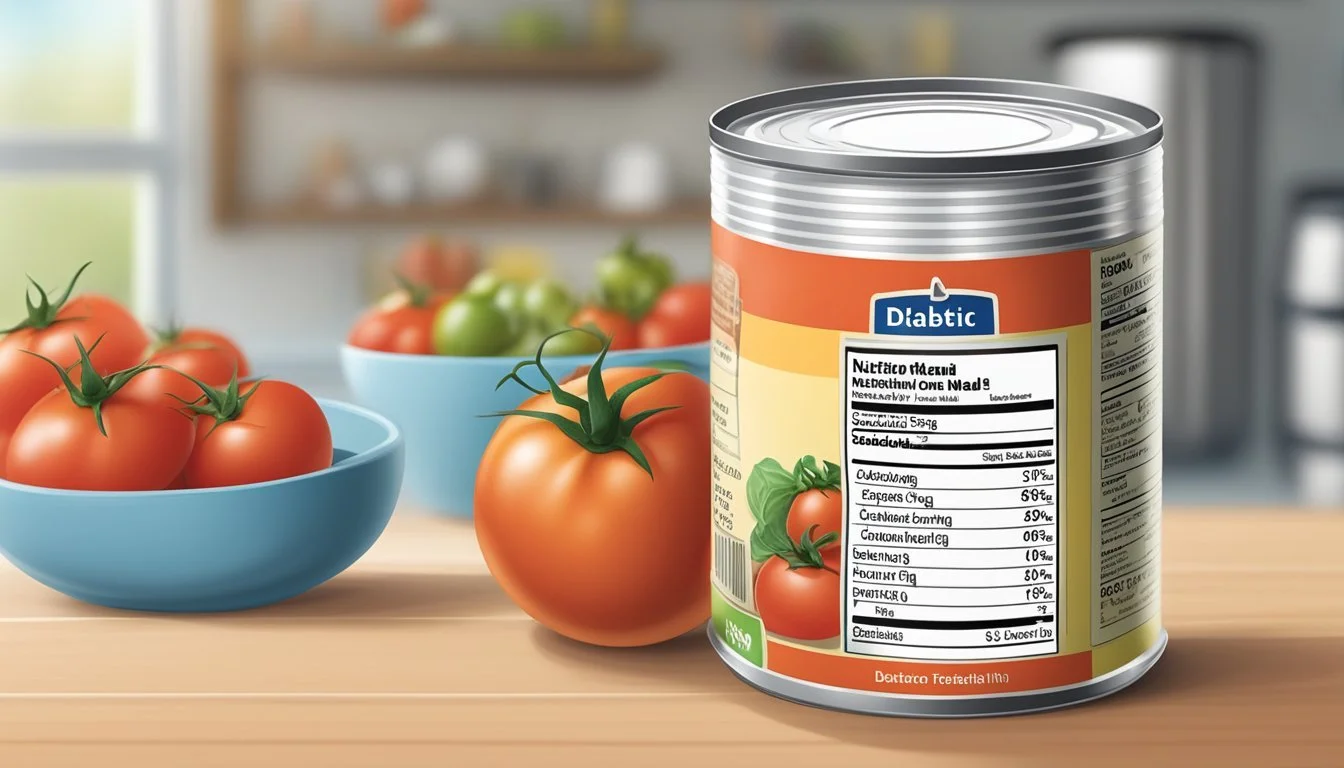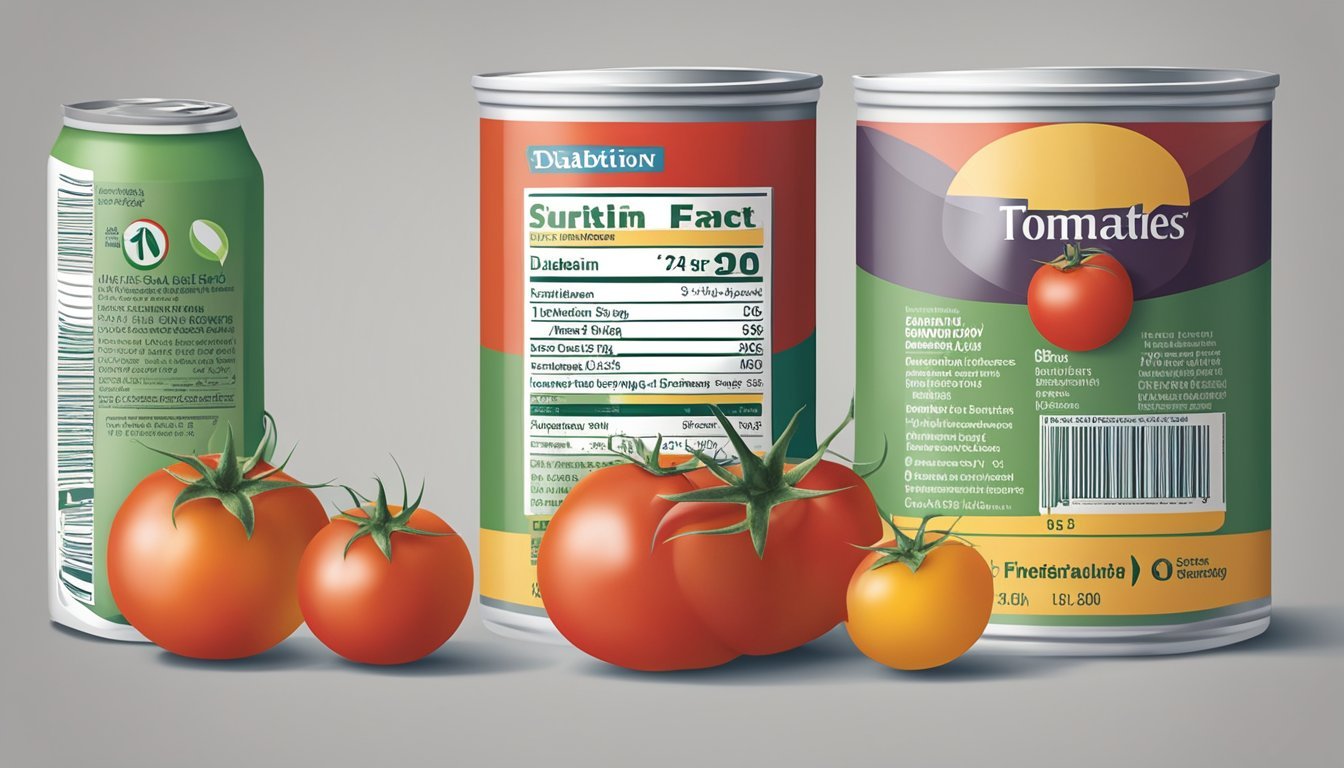Can Diabetics Eat Canned Tomatoes with Added Sodium?
Understanding Dietary Choices
Diabetes management often involves careful dietary choices, particularly when it comes to processed foods. One common question is whether diabetics can safely consume canned tomatoes with added sodium. Diabetics can eat canned tomatoes with added sodium, but it's crucial to monitor and limit the intake due to potential impacts on blood pressure and overall health.
Fresh tomatoes are naturally low in carbohydrates and provide a good source of vitamins and fiber. Canned tomatoes, however, often come with added sodium to enhance flavor and preserve shelf life. High sodium intake can lead to increased blood pressure, complicating diabetes management and increasing the risk of cardiovascular issues.
It is advisable for diabetics to opt for low-sodium or no-salt-added varieties of canned tomatoes whenever possible. Checking labels for added sugars and sodium content can also help in making healthier choices. Incorporating canned tomatoes into meals while maintaining control over other sources of sodium in the diet can lead to better health outcomes.
Understanding Diabetes and Diet
Effective diabetes management relies heavily on diet, which can significantly influence blood glucose levels and overall health. Sodium intake, when too high, can also affect blood pressure, complicating diabetes management.
Role of Diet in Diabetes Management
In diabetes, managing blood glucose levels is critical. Food choices directly impact these levels, making a diabetic diet essential. Emphasis is placed on low glycemic index foods, which cause slower increases in blood sugar. Foods rich in fiber, such as whole grains, vegetables, and legumes, help with slower absorption of sugar and reduced blood glucose spikes.
Carbohydrates significantly impact blood sugar. Hence, counting carbs and distributing them evenly throughout the day is advised. Proteins and healthy fats are important, too. They provide energy without rapidly raising blood sugar levels.
Impact of Sodium on Blood Pressure
Sodium, commonly found in salt, affects blood pressure by retaining water, increasing blood volume, and requiring the heart to work harder. For diabetics, blood pressure management is crucial because they are already at higher risk for cardiovascular issues.
Reducing sodium intake can help manage blood pressure. This includes avoiding high-sodium processed foods and opting for fresh or low-sodium alternatives. Monitoring sodium intake alongside regular blood pressure checks assists in comprehensive diabetes management, potentially reducing complications such as heart disease and stroke.
Nutritional Profile of Canned Tomatoes
Canned tomatoes are a convenient and nutrient-rich option for those looking to enhance their diet. They provide an array of vitamins, minerals, and antioxidants, but it's important to be mindful of their sodium content.
Key Vitamins and Minerals in Tomatoes
Canned tomatoes are rich in essential vitamins and minerals. They are particularly high in vitamin C, which supports the immune system and skin health. Vitamin A is another key nutrient, important for vision and immune function.
Other significant micronutrients include potassium, which helps regulate blood pressure, and folate, which is crucial for DNA synthesis and repair. Calcium and iron are present in smaller amounts, contributing to bone health and oxygen transport, respectively.
Sodium Content in Canned Tomatoes
The sodium content in canned tomatoes varies depending on the brand and whether the product has added sodium. 100 grams of canned tomatoes can contain anywhere from 230 to 350 mg of sodium, which is considerably higher than fresh tomatoes.
For individuals managing diabetes, high sodium intake can exacerbate conditions such as hypertension. It is advisable to look for low-sodium or no-salt-added options to better control sodium intake. Always check the nutrition labels to make an informed choice.
Fiber and Antioxidants in Tomatoes
Canned tomatoes are a good source of dietary fiber, with about 2 grams per 100 grams. Fiber is essential for digestive health and helps regulate blood sugar levels.
Another standout feature is their antioxidant content, notably lycopene, which gives tomatoes their red color. Lycopene has been linked to various health benefits, including reduced risk of heart disease and cancer.
Additionally, canned tomatoes contain other antioxidants like vitamin E and beta-carotene, which combat oxidative stress in the body. These properties make canned tomatoes a valuable addition to a diabetes-friendly diet.
Benefits of Tomatoes in a Diabetic Diet
Tomatoes offer a variety of benefits for individuals managing diabetes, particularly due to their nutrient profile. They are low in carbohydrates and have compounds like lycopene that promote heart health and aid in blood sugar control.
Lycopene and Heart Health
Lycopene, a natural pigment that gives tomatoes their red color, acts as a powerful antioxidant. It helps reduce the risk of cardiovascular disease by lowering oxidative stress and inflammation. For diabetic individuals, reducing heart disease risk is crucial, as they are more vulnerable to cardiovascular issues.
Studies have demonstrated that lycopene improves endothelial function and reduces arterial stiffness, which promotes heart health. Including tomatoes in a diabetic diet can help mitigate these risks, potentially reducing reliance on other heart-protective measures.
Low-Carb Benefits for Blood Sugar Control
Tomatoes are low in carbohydrates, containing about 4 grams of carbs per medium-sized tomato. This low-carb content means they have a minimal impact on blood sugar levels and are suitable for those managing type 2 diabetes.
The low glycemic index of tomatoes helps maintain stable blood sugar levels. This is particularly important for diabetic patients, as it aids in weight management and overall blood sugar control.
Incorporating tomatoes into meals, whether raw or cooked, ensures a nutrient-rich addition that supports healthy blood sugar levels without spiking them. This makes tomatoes a versatile and beneficial choice for diabetes-friendly diets.
Combining their heart-protective benefits and low-carb profile, tomatoes are an excellent dietary addition for individuals managing diabetes.
Culinary Uses of Canned Tomatoes
Canned tomatoes offer versatility in the kitchen, especially for those managing diabetes. They can enhance a variety of dishes while helping to maintain healthy blood sugar levels, given careful attention to sodium content.
Incorporating Canned Tomatoes into Diabetes-Friendly Recipes
Canned tomatoes can be a staple in many diabetes-friendly dishes. For example, adding canned tomatoes to a hearty vegetable soup not only enhances flavor but also boosts the nutritional value with fiber and vitamins.
They are great in casseroles. Mixing them with non-starchy vegetables and lean protein like chicken or beans makes for a balanced meal. For a simple salad, combine diced canned tomatoes with Greek yogurt for a creamy, tangy dressing.
Salsas made from canned tomatoes can serve as a tasty dip or topping. Use them to create tomato-based sauces for zucchini noodles or other low-carb pasta substitutes. Opt for recipes that avoid added sugar to maintain a balanced diet.
Low-Sodium Tomato-Based Options
It's crucial for diabetics to choose low-sodium canned tomatoes to avoid excessive salt intake. Many brands offer low-sodium alternatives that can be used in various dishes without compromising on taste.
When preparing canned tomato soup, start with a low-sodium base and add your own spices and herbs to enhance flavor naturally. Consider combining canned tomatoes with other non-starchy vegetables and lean proteins to create balanced meals that won't spike blood sugar levels.
For those monitoring their sugar intake, always check labels for added sugars. Choose canned tomatoes without added sugars to ensure a healthier option. This is particularly important in preparing diabetes-friendly meal plans focused on maintaining weight and managing blood sugar levels effectively.
Managing Sodium in Canned Tomatoes
Managing the sodium content in canned tomatoes is essential for diabetics due to the potential impacts on blood pressure and overall health. Proper selection and preparation methods can significantly reduce the amount of sodium consumed.
Choosing Low-Sodium Varieties
Checking Labels: When purchasing canned tomatoes, it's crucial to read labels carefully. Opt for products labeled as "low-sodium" or "no salt added." These options typically contain less than 140 mg of sodium per serving, compared to regular versions which can have 200-400 mg.
Brands and Varieties: Some brands offer specialized low-sodium products. Choosing these can support a diet aimed at managing blood pressure and reducing the risk of hypertension. Varieties like diced, crushed, or whole tomatoes are available in low-sodium options.
Health Benefits: Selecting low-sodium canned tomatoes can help diabetics maintain healthier blood pressure levels without sacrificing nutritional benefits such as fiber and vitamins. Incorporating low-sodium choices supports an overall balanced diet.
Rinsing to Reduce Sodium
Effectiveness: Rinsing canned tomatoes under cold water can reduce sodium content significantly. While not all sodium can be removed, studies suggest that rinsing can wash away up to 40% of the sodium.
Method: To rinse canned tomatoes, pour them into a colander and rinse thoroughly with water for about 30 seconds. This process is simple and effective at reducing overall sodium intake from canned foods.
Practical Tips: Rinsing is particularly useful when low-sodium varieties are unavailable. By incorporating this step, diabetics can better manage their sodium intake, aiding in the control of blood pressure levels.
Using these strategies helps diabetics enjoy the convenience and nutritional benefits of canned tomatoes while managing sodium intake effectively.
Complementary Foods and Nutrition
Incorporating canned tomatoes with added sodium into a diabetic-friendly diet involves complementing them with foods that enhance their nutritional benefits. Key pairings include non-starchy vegetables and lean proteins, as well as adding healthy fats and flavor enhancers.
Pairing with Non-Starchy Vegetables and Lean Proteins
Canned tomatoes pair well with non-starchy vegetables like bell peppers, spinach, and cucumbers. These vegetables are low in carbohydrates and high in essential nutrients, making them suitable for blood glucose management. Including these veggies can help balance the sodium content from the canned tomatoes.
Lean proteins such as grilled chicken, tofu, and canned tuna packed in water also complement canned tomatoes. These proteins provide essential amino acids and help maintain muscle mass without adding excessive calories. Combining tomatoes with lean proteins ensures a filling and nutritious meal.
Adding Healthy Fats and Flavor Enhancers
Healthy fats can be added to dishes with canned tomatoes to enhance both flavor and nutritional value. Olive oil is an excellent choice, offering omega-3 fatty acids that support heart health. A drizzle of olive oil can improve the absorption of fat-soluble vitamins from vegetables.
Flavor enhancers like garlic, lemon juice, and herbs (such as basil or oregano) can elevate the taste without significantly increasing caloric intake. Garlic contains beneficial flavonoids that can support the immune system, while lemon adds a refreshing zest and vitamin C. These additions make meals more enjoyable and nutritious without compromising on health.
Considerations for Diverse Types of Diabetes
Both Type 1 and Type 2 diabetes require unique considerations when it comes to consuming canned tomatoes with added sodium to maintain stable blood sugar levels and overall health.
Adjustments for Type 2 Diabetes
For individuals with Type 2 diabetes, watching carbohydrate intake is critical. Canned tomatoes are generally low in carbohydrates and net carbs, making them a potentially safe option. However, the added sodium can be a concern as it may contribute to high blood pressure, which is often a comorbidity in Type 2 diabetes.
Those with Type 2 diabetes should opt for canned tomatoes with no added salt or low sodium versions. This helps in managing both glucose levels and blood pressure effectively. Monitoring nutritional labels on canned products is essential to ensure a balanced intake of carbs without excessively increasing sodium levels.
Monitoring Blood Sugar for Type 1 Diabetes
Individuals with Type 1 diabetes need to closely monitor their blood sugar levels. Canned tomatoes are beneficial due to their low carbohydrate content, which minimizes significant blood sugar spikes. When including canned tomatoes in meals, it's crucial to count carbs accurately and adjust insulin doses accordingly.
Additionally, the sodium content in canned tomatoes can affect hydration and blood pressure. Thus, choosing canned tomatoes without added sodium or rinsing them before use can mitigate these issues. Regular blood glucose monitoring before and after meals that include canned tomatoes is recommended to ensure stable blood glucose levels.
Precautions and Recommendations
When considering canned tomatoes with added sodium, there are vital precautions to take and specific recommendations to follow. Monitoring sodium intake and consulting with healthcare providers can help manage the impact on blood sugar and overall health.
Reading Nutrition Labels
Reading and understanding nutrition labels is crucial for managing diabetes. Look for sodium content and try to choose options with no added salt or low sodium. Many canned tomatoes can have high levels of sodium, which can affect blood pressure and overall health.
Pay attention to other elements on the label such as calories, added sugars, and carbohydrates. Opting for products that have lower sugar and carbohydrate content can help maintain a diabetes-friendly diet. High dietary fiber content can also be beneficial as it helps regulate blood sugar levels.
Discussion with Healthcare Providers
Consulting healthcare providers is essential when incorporating canned tomatoes into a diabetic diet. They can provide personalized advice based on individual health needs.
Healthcare providers can help determine the appropriate daily sodium intake to avoid potential health risks such as high blood pressure or cardiovascular issues. They can also recommend specific products or brands that are better suited for diabetic individuals based on nutritional content. Regular consultation ensures that dietary changes do not adversely affect chronic conditions or diabetes management.
Creating a meal plan that includes canned tomatoes in a safe and healthy manner is important for long-term health benefits.
Conclusion
Canned tomatoes can be a part of a diabetic diet, but it's essential to be mindful of the sodium content.
High sodium levels can negatively affect blood pressure, which is a concern for diabetics. It's advisable to opt for low-sodium or no-salt-added versions when available.
Despite the sodium, canned tomatoes provide valuable nutrients like lycopene, which has antioxidant properties, and vitamin C.
Additionally, they offer dietary fiber, which helps in managing blood sugar levels. Moderation and careful selection are key. Choosing products with minimal added ingredients can make a significant difference.










